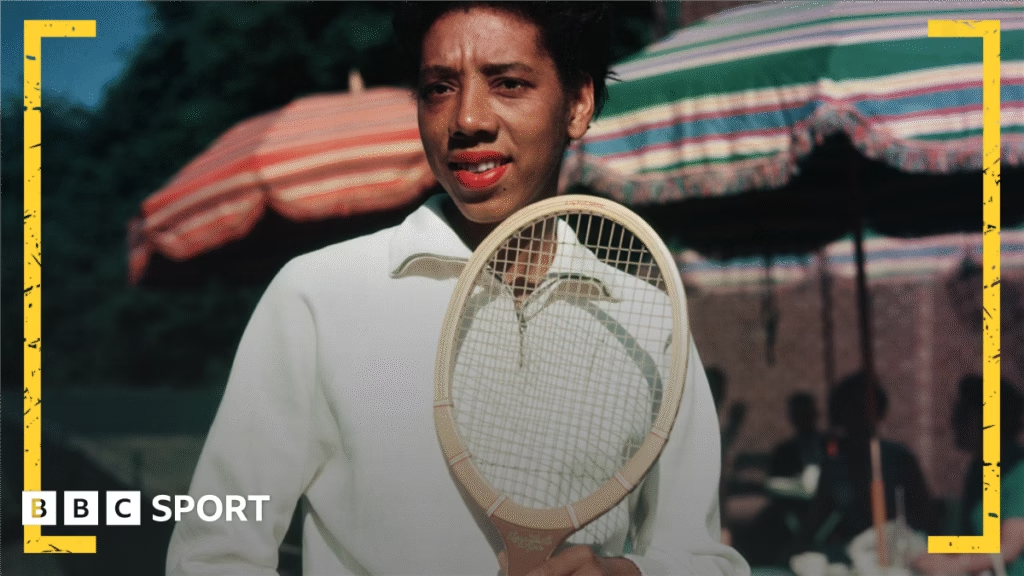Gibson was raised in a small apartment block on West 143rd Street, between Lenox Avenue and Seventh Avenue, a cross-section blocked off every afternoon to become a ‘play street’, where inner-city children without access to a park could run around and practise sport in a safe space.
These days, the narrow avenue – typically Harlem with five-storey blocks of rented flats guarded by London plane trees and lines of cars on each side of the one-way road – is not taped off.
On a sweaty August afternoon, even when local children are out of school for the summer holidays, it is virtually silent.
Back when Gibson was growing up, in the 1930s and 1940s, it would have been a hive of activity, shrieking kids running around playing stickball, punchball, marbles and a variety of tag games. And as fate had it, there was another activity taking place on the doorstep of her childhood home.
“It all started with paddle tennis on the play streets of New York City,” Gibson told a BBC Radio 4 programme in 1989.
“Two bats and a sponge rubber ball. A short net and a short court. A friend of mine came round, we saw the bats and ball on the paddle tennis court so we started hitting back and forth.
“From that moment on we would get up in the morning as soon as they laid the court. That’s how I got started.”
The tall, athletic teenager with a fierce will to win and streetwise spirit – said to have been borne out of her father forcing her to fight him on the rooftop of their apartment block – began to attract attention.
Buddy Walker, the organiser of the play street on West 143rd, and a bandleader at a Harlem bar run by Robinson, spotted this precocious talent and took her to the Cosmopolitan Club, a private tennis club for the black middle classes in West Harlem.
There she started having lessons with the club’s one-armed professional, Fred Johnson. He honed her raw talent and developed the powerful serve and athleticism that became hallmarks of her game.
Gibson, who had been playing truant and sometimes slept on the subway to avoid going home, had the on-court talent. She struggled more when mixing with the doctors, lawyers and scholars who also played at the Cosmopolitan.
“She was a blue-collar kid and the black folks playing tennis were the bourgeoisie, who would try to school her in etiquette,” Rex Miller, a film director inspired to produce the documentary Althea after seeing a picture of his mother playing against Gibson, tells BBC Sport.
“But she was rebellious, even against more well-to-do blacks. When people are doing things for you it usually comes with strings attached so she had a way of alienating people who would ask her to do things.”
That unwillingness to co-operate changed after she met the men described by Davis as “the two godfathers of black tennis in America”.
Dr Hubert Eaton and Dr Robert Johnson, two scholars with notable tennis ability who nurtured promising black players, spotted Gibson at the all-black American Tennis Association (ATA) national championship in 1946 and were astounded by her natural, yet combustible, ability.
Here, they thought, might be their Jackie Robinson – an athlete who could break down the racial barriers in tennis just like the Harlem-based Brooklyn Dodgers star was doing in baseball.
While excited by her talent, they felt her lack of education and discipline would hamper her progress. So they concocted a plan: she would live and train with Dr Eaton, the chief surgeon at the African-American hospital in Wilmington, North Carolina, during the school year, then stay with Dr Johnson in Lynchburg, Virginia, in the summer.
“Both Dr Eaton and Dr Johnson were what you referred to then as ‘racemen’,” Miller says.
“Both were civil rights organisers and they had a plan to create the first black tennis champion. Althea was their charge.”
Discover more from 6up.net
Subscribe to get the latest posts sent to your email.


